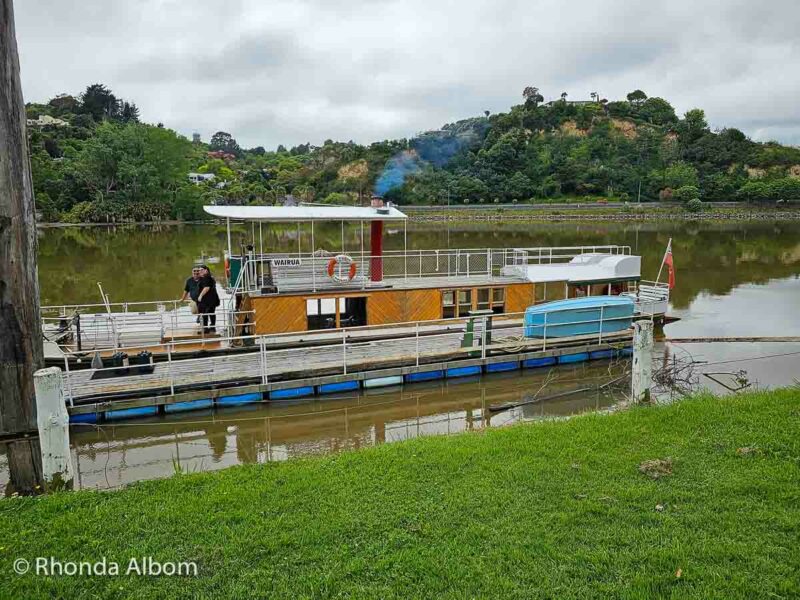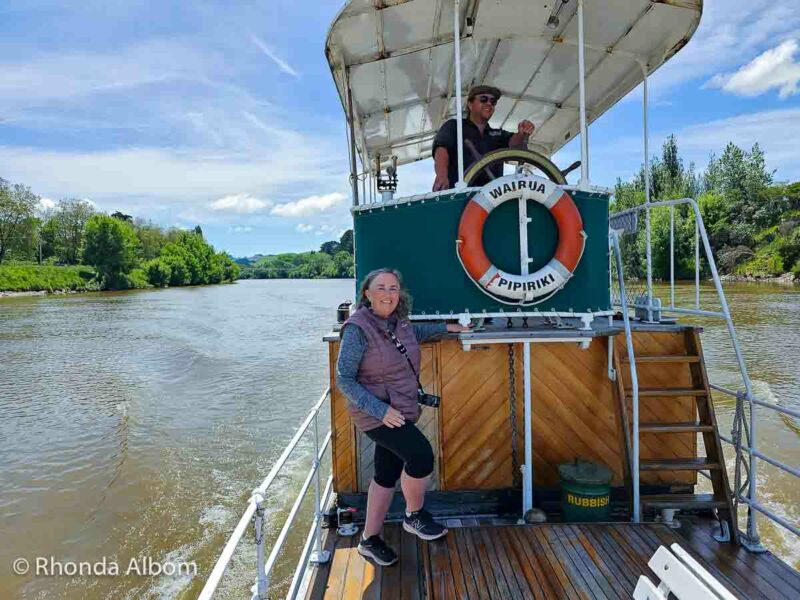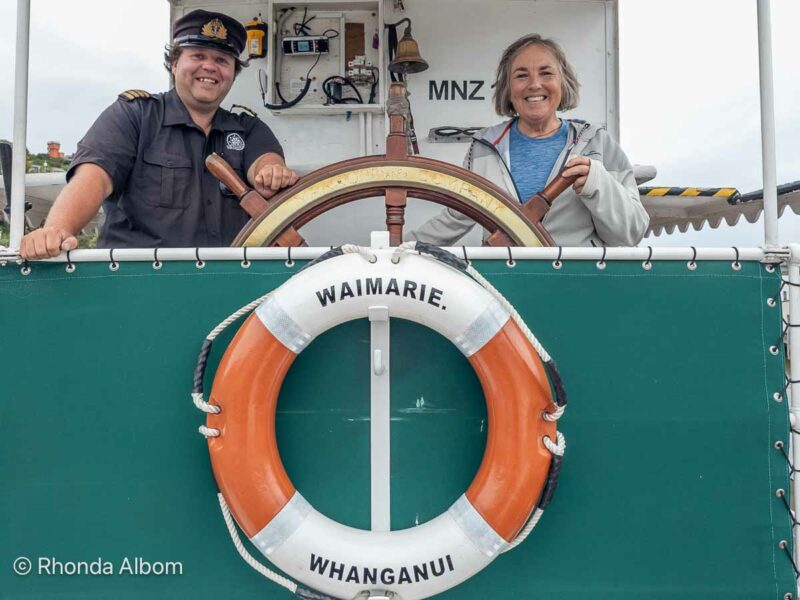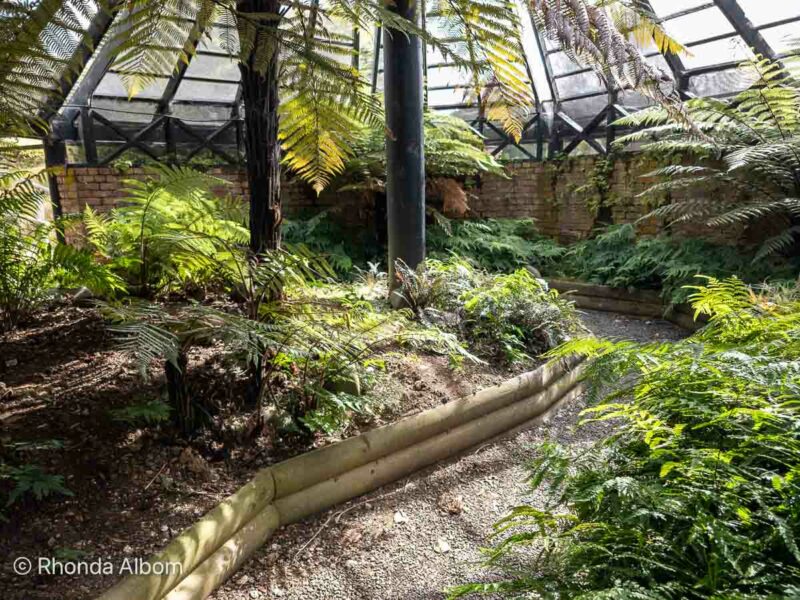Our second visit allowed us to discover many more things to do in Whanganui. Nestled along the scenic banks of the Whanganui River, the town boasts a rich history that dates back to the early interactions between European settlers and the indigenous Māori people.
Originally a Māori Pa, then later established as a trading post in the mid-19th century, Whanganui quickly evolved into a pivotal hub for commerce and cultural exchange and a vital river port. Today, it’s also known for its early 20th-century architecture and arts scene.
Two stand-out activities clearly top our list of things to do in Whanganui. First, we savoured the gentle meander of a riverboat cruise, then we walked through the Durie Hill tunnel, ascended the earthbound elevator, and climbed the Durie Hill viewing platform.
Rounding out our list, we took a leisurely stroll around Virginia Lake, enjoyed the black-sand beaches, explored some of the art galleries, and visited museums.

Where is Whanganui?
Whanganui is on the west coast of the North Island, where State Highways 3 and 4 intersect. It’s about 200 kilometres (125 miles) north of Wellington, about 160 km (99 miles) south of New Plymouth, and 75 kilometres (47 miles) northwest of Palmerston North.
The map features our five must-see attractions in red and additional interesting things to do in yellow. Information on all of them is below.
Whanganui vs Wanganui
Formerly spelled Wanganui, the government officially changed its name to Whanganui in 2009. This change is more than just a shift in letters. It representes a significant step towards acknowledging and respecting the Māori language and culture.
Top things to do in Whanganui
Don’t have time to read the entire article? Here are the top five must-dos in Whanganui – with plenty more details on all of them below.
- Take a Whanganui Riverboat Cruise
With two options to choose from, this is one of the must-do activities in Whanganui. - Walk through the Durie Hill Tunnel, take the elevator up to the top, and enjoy the view from one of the two towers at the top.
- Take a relaxing stroll around Virginia Lake
- Head to one of the black-sand beaches.
- Enjoy the art scene.
- Visit a museum, a garden, or a park.
Whanganui Riverboat Cruise


The Whanganui River is the longest navigable river in NZ and was once the primary route for trade in the region.
Today, two historic riverboats remain, and both take passengers on what we found to be a relaxing, enjoyable, beautiful, and historic river exploration. Both follow similar routes, cruising past lush green hills, under bridges and past several historic sights along the Whanganui River.
Competitors, yet friends as is common in smaller NZ cities, the two boats’ schedules don’t overlap. So, your choice might be dictated by the day you are there, but either way, we encourage you to add one to your list of what to do in Whanganui. We have sailed on both.
1. Motor Vessel Wairoa


This was our choice on our first visit, and we loved it!
While we were intrigued by the original features of this historical ship, it was Capitan Sam’s knowledge, fascinating stories, and entertaining manner that made our tour so memorable. His wealth of general knowledge and history shines through stories from his 20 years on the river.
The ship was built in the UK and joined the Hatrick & Co Whanganui River Steamer fleet in 1904. Its specialty was traversing shallow waters as its propulsion is through a tunnel drive or raised propeller boat. The vessel was brought up to modern safety standards and is otherwise original.
The Motor Vessel Wairoa currently runs two-hour tours on weekdays that travel about 12km upstream before returning. There is both covered and open seating and a toilet onboard.
Learn more or book your tour here. You can also inquire about custom trips, such as onboard weddings or barbeque sails.
2. Paddle Steamer Waimarie



A second visit allowed us to get out on the Paddle Steamer Waimarie, and to our surprise it was skippered by Capitan Sam (helping out) on that day. In the warm summer months, it runs two-hour tours up to six days per week.
The Paddle Steamer Waimarie is New Zealand’s only authentic coal-fired passenger paddle steamer in operation and is believed to be the only one in the southern hemisphere. Interestingly, it operated 100 years ago on this waterway, sank in mud, and was relaunched in 2000 after a complete restoration following 50 years at the bottom of the river.
There are a few fun onboard surprises, like a homing carrier pigeon that brings a message from the ship back to the starting point. On board, there are both covered and open outside areas, two indoor saloons, two toilets and food available.
We opted for the Paddle and Pedal experience, where we take the boat for an hour to Upokongaro and then cycle back along the river.
While I stayed on the boat due to the rain, Jeff and our daughter took the bikes and reported that I missed out on loads of fun. The ride wasn’t too long, and it took them about an hour to leisurely cycle back, stopping several times for photos. They reported only a few small hills but did think it’s best suited for those in at least moderate shape. Learn more or book your tour here.
3. Waimarie Riverboat Museum

Regardless of which boat you choose, we found the Waimarie Riverboat Museum interesting and recommend a quick visit if you have time.
Durie Hill elevator and viewing platform


Durie Hill is a steep hill across the river from Whanganui.
Back in 1910, a public transit system was needed to develop the Durie Hill suburb. It was too steep for a cable car. The solution opened in 1919. It’s a heritage-listed 213m tunnel from the riverfront into the hill and a 66m elevator up to the top.
Walking through the Durie Hill tunnel to the elevator


On our second visit, we walked over the bridge from town, entered the tunnel, explored both towers and then walked down. This was a much better option than the first time when we drove to the top, took the elevator down, and then had to come back up to get our car.
There’s a staircase to the right of the tunnel entrance, followed by a trail that leads to the same spot. The elevator, as part of the public transit system, is only $2, and it’s a fun experience in at least one direction.
At the end of the tunnel, we pushed the button, and the elevator appeared. One person operates it and spends their day talking about it as they shuttle people up and down. They also sell tickets, so there is no need to get them in advance.
Durie Hill observation platform


At the top, a set of spiral stairs outside the elevator’s building led us to a viewing platform where we enjoyed a bird’s-eye view of the town and the meandering Whanganui River. The stairs are free to climb.
Durie Hill Memorial Tower


On the same grounds at the top is the 33.5m memorial tower, which is also free to climb. The 176 spiral steps to the top seemed to go on forever, but the views from the top were worth the effort.
On a clear day, they say you can see all the way to the top of the South Island, as well as spotting Mt Ruapehu and Mt Taranaki.
Rotokawau/ Virginia Lake Reserve

Virginia Lake was our first stop in Whanganui, as we arrived from the North while travelling from Taranaki to Wellington. What we found was a peaceful oasis, a haven for a relaxing stroll around the lake.
With four well-maintained paths, we opted for the one closest to the water, aptly named the Lower Track. We found this 1.7km walk took us only about 30 minutes to get around the lake. The easy walk was suitable for pushchairs (strollers), and vibrant gardens and waterfowl surrounded us.
Head to a beach

With all the fabulous old buildings, it’s easy to forget that Whanganui also has some beautiful beaches. Castlecliff is the closest family-friendly beach, whereas South Beach is the nearby surfer’s beach.
While they are both lovely, we spent our beach time a bit farther at Kai Iwi Beach. We started above the beach at the lookout point, and while it’s an excellent spot for freedom campers or starting a short hike down to the beach, I believe the coastal views of the Tasman Sea were better down by the water.
We arrived close to high tide (on a cool spring day), and as a result of the tide, the beach was seriously reduced to the south of the lifeguard station, but there was plenty of golden and black sand to the north.
Aside from the long stretch of lifeguard-patrolled beach, there is an impressive playground for kids, wood-burning barbeques, two bridges, showers, and toilets.
Check out the art scene
This is the number one reason we headed back to Whanganui. Famous for its art scene, we were glad to spend time exploring many of the over 90 galleries. The best time to go is in March to enjoy the famous arts trail.
Sarjeant Gallery Te Whare o Rehua

Reopened in Jan 2025 after being closed and redeveloped for a year, we finally had a chance to visit Sarjeant Gallery to see some of its 8,000+ items spanning over four hundred years of European and New Zealand art history. The gallery is now located in Pukenamu Queen’s Park. Free entry.
Quartz Museum of Studio Ceramics

A fascinating collection of ceramics, this place does not allow photos inside. Free to enter.
New Zealand Glassworks

The National Centre for Art Glass helps unite the glass arts community in Whanganui and New Zealand by providing gallery space and private workshops where people can try their hand at glass blowing. We watched the workshop and enjoyed the gallery. Free to enter.
Street art

Fascinating street art all over the city. We just had to keep our eyes open.
Whanganui Collegiate School


Whanganui is also home to one of the country’s oldest and most prestigious secondary boarding schools (high school). Founded in 1854, the Whanganui Collegiate School is known for its academic and sporting excellence and its nationally significant collection of architectural styles. We were lucky enough to meet a curator who invited us on campus for a visit.
More free things to do in Whanganui



Not only are there plenty of things to do in Whanganui, but each of the venues listed here is free to enter.
Additional outdoor things to do in Whanganui
- Take a stroll along the river
There is a lovely riverfront boardwalk that we enjoyed in the early evenings. - Bason Botanic Gardens
The best way to see this place is to drive through once, then go back the second time, stopping to walk and explore the sections that interest you. We were super tired by the time we got here, but we still found a few of the areas stunning and worth getting out of the car for. - Kowhai Park
A must-visit in Whanganui if you have young children, this large riverside park has playful and quirky playground equipment, including climbing and water options.
- Cooks Gardens
This running track and athletic field is where Sir Peter Snell broke the world record with a 3 min 54.4-second mile record in 1962. There’s a plaque commemorating it. On the day we visited, the Hurricanes were practising, and there were plenty of people watching. - Bushy Park Wildlife Sanctuary
A forest sanctuary supported by local Māori and Forest and Bird, it has a homestead with available accommodation and a food venue. We have not visited yet. - Whanganui River Traders Market
If you are here on a Saturday morning, this is a fun option for food and local crafts. Open Saturdays from 8:30am until 1pm. - Moutoa Gardens
Moutoa Gardens, also known as Pakaitore, is a cultural and historical hub in Whanganui and is significant to the Māori people. While tensions around it fluctuate, it has been a source of much controversy.
Indoor things to do in Whanganui
- Whanganui Regional Museum
A chance to learn more about the region and its people, the museum is famed for its Taonga Maori Collection, although no photos are allowed. There is also the impressive Gottfried Lindauer exhibit of Maori portraits, which was one of my highlights. We have heard it’s one of the best museums in New Zealand. - St. Paul’s Memorial Church
Consecrated in 1937, you’ll want to visit this heritage-listed church for its beautiful Māori decorations. We did not see this one.
Whanganui accommodation


We have two favourite spots for different reasons. They are a block apart, so the location is similar.
- Rutland Arms Inn
With its high ceilings and elegant decor, this classic New Zealand pub hotel is a fun place to stay if you travel alone or as a couple. It’s right in town. The pub fills up at dinnertime, so book in advance if you want to eat here. Reserve your stay at Rutland Arms Inn here. - Johnston Apartments
If lots of space, stunning accommodations, and location are your top priorities, this one is for you. Located at the city bridge, it’s an easy walk to the tunnel or just about anywhere we went. The only downsides are that there is no elevator and two long flights of stairs, and the street noise is bad enough that they provided earplugs in the room. Reserve your stay at Johnston Apartments here.


Denise
I love that there are so many free things to do in Whanganui!
Melinda
I’m sure there’s even more to do in Whanganui! Hopefully I can make it there for the art trail on my way back north. Thanks for the tips!
Kelly Francois
I always love taking a riverboat cruise when I visit a new destination. It gives a different perspective.
Jan
I love Whanganui! I visited this beautiful town a decade ago and enjoyed a couple of days. My favorite is the Durie Hill tunnel and elevator and the spectacular views from the viewing platform above. The beach view looks awesome! 🙂
Michelle
Whanganui sounds like such a charming city. I would definitely want to do the river cruise! Thanks for introducing me to a new destination!
Josy A
The Durie Hill tunnel to the elevator is pretty cool isn’t it! That’s not something you see every day! I really like the sound of the river cruise as well…getting to see all that beeeautiful green countryside from the banks of the river.
Matt
The Sarjeant Gallery Te Whare O Rehua is not “permanently closed”. Please correct your article.
“The redeveloped Sarjeant Gallery Te Whare o Rehua Whanganui will open on Pukenamu Queen’s Park in mid 2024”
Rhonda Albom
Thanks for catching this.